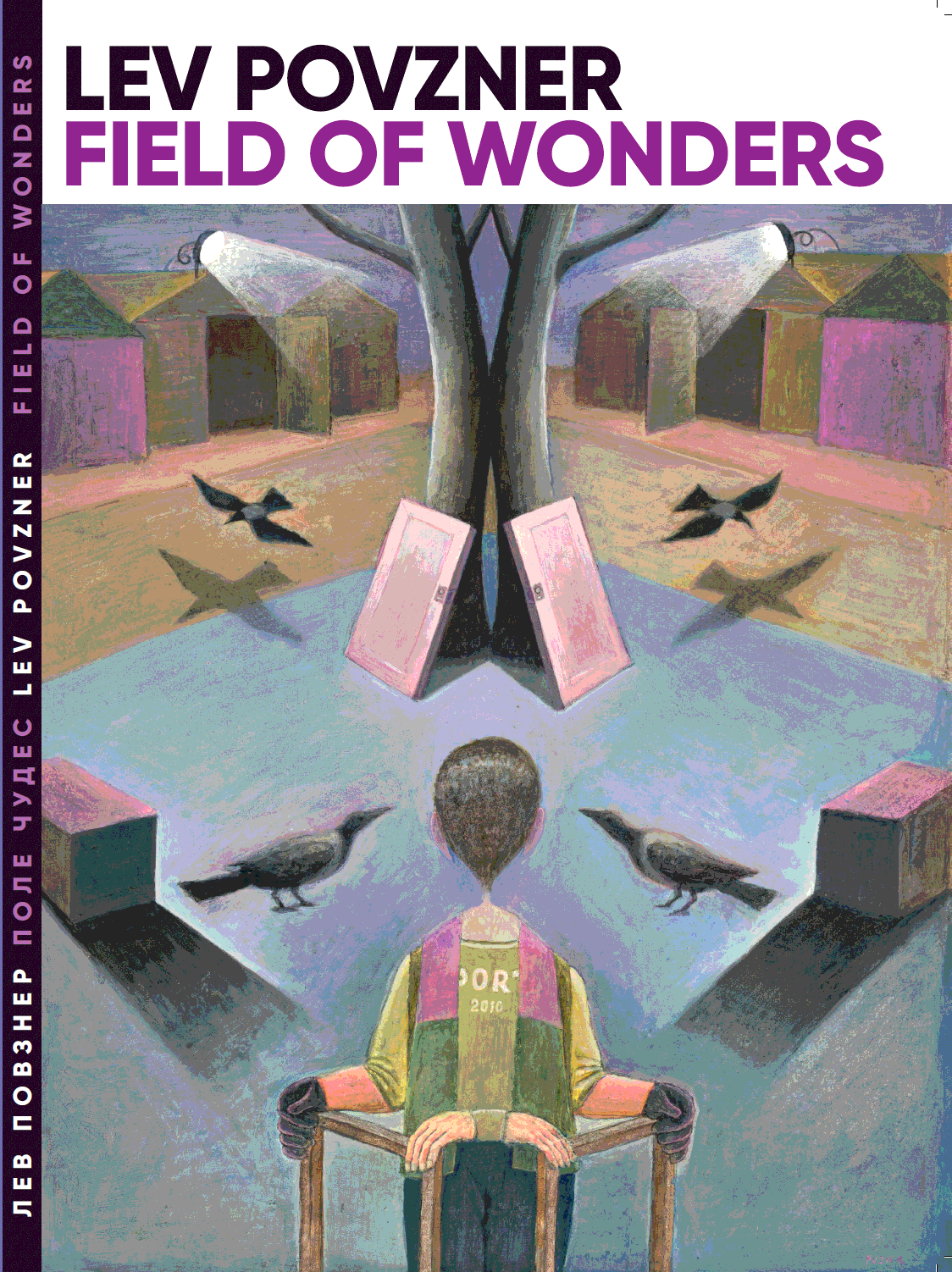Lev Povzner's artistic development began in the mid-1960s when he joined the ranks of the artistic underground. After graduating from the Moscow Polygraphic Institute, Povzner started exhibiting alongside Evgeny Izmailov and Mikhail Roginsky, actively participating in apartment exhibitions. During those years, the artist was fascinated by nostalgic "retro" – the art of old European masters. He was also interested in primitive art, lubok, and kitsch. In 1975, his works were displayed at the legendary Exhibition of Works by Moscow Artists in the "House of Culture" pavilion at VDNKh. In 1976, Povzner was admitted to the Moscow City Committee of Graphic Artists, and in 1982, to the Union of Artists of the USSR. By the late 1990s, Povzner moved away from romanticism and defined himself as a postmodernist. This phase of his work is the focus of our exhibition.
The main painting and graphic series of the exhibition is "Hidden Faces." Using a technique called "polymorphism," Povzner inventively creates "trompe-l'oeil" works where hidden and substitutive meanings coexist at different levels of perception, and deciphering these encrypted messages becomes part of the viewer's interaction with the artist.
Each subsequent series is also built on the development of a specific technique. The series "Grass" (2000-2010s), dedicated to anthropomorphic flowers, is markedly psychedelic. In the series "Spiegel" (2010s), a surrealist effect is achieved through the symmetrical "mirroring" of one half of the image onto the other. The cycle "Field of Wonders" (2018 - present) often employs the "painting within a painting" technique. Meanwhile, the "Psycho" series is simply universal, despite the distinctiveness of the author's style.

Lev Povzner: The Script of Dispersal
Sergey Khachaturov is an esteemed art critic, theorist, curator, and art historian with a significant contribution to the field of Russian art studies. He holds a candidate degree in art history and serves as an associate professor at the Department of the History of Russian Art at the Historical Faculty of Moscow State University (MSU). Additionally, Khachaturov is a lecturer at the Moscow School of Photography and Multimedia named after Alexander Rodchenko.
The unofficial art of the post-war USSR is rich with various systems and styles. Today, these are often combined with global trends in modernist and postmodernist art, which Soviet artists only intuitively sensed. It turns out that Eli Belutin is close to Dubuffet and Art Brut, while Mikhail Chernishov aligns with American Minimalism and Pop Art. It seems each artist can be categorized and labeled... However, this generation of unofficial masters includes such geniuses that challenge systematic cataloging. Their art appears to parody the sanctity of doctrinaire rigidity. They act out, obscure trails, and stage a carnival of masks.
The foremost such genius—an artist of mischief—is Moscow-based Lev Povzner. In the 1960s, he studied at the training ground of Moscow conceptualism—the Polygraphic Institute (colloquially known as "Polygraph"). There was far more freedom here than in Soviet academies. In the mid-60s, Povzner joined the realm of unofficial art. In 1967, a triad of artists—Lev Povzner, Mikhail Roginsky, and Evgeny Izmailov—formed the "Union of Three," which lasted until the late 1970s. Povzner actively exhibited in apartment shows and participated in the famous nonconformist exhibition of 1975 at the VDNH House of Culture.
The artist adheres to his method of working in series and creating compositions based on the principle of anamorphosis, which involves hiding images and confusing trails. Profiles are encrypted in snowy landscapes, and a kitten transforms into a pupil of an eye. Optical displacement promises pleasure akin to the magical images of childhood.
For Povzner, anamorphosis is not merely a playful trompe l’oeil technique. In the perspective of art history, it is a crucial method for dissecting and assembling various presentation systems, their ironic deconstruction, and living in new contexts. Lev Povzner keenly understands the essence of collage postmodernism with its play of quotations and total irony toward the grand dictatorship of great meanings. However, in my opinion, his postmodernism becomes a powerful means of finding one's own position of non-arrival, estrangement, and freedom of interpretation across different systems. In his series with encrypted faces, Povzner transcends the situation of being trapped by various "isms" and overly conventional, formatted systems of interpretation and evaluation. In the script of dispersal, he finds freedom.
The large works created with acrylic on oilcloth and oil on canvas in the late 1990s are a magnificent example of what literary critics call the "unreliable narrator." Villages, barracks, landscapes, and profiles of people form compositions with the artist’s beloved "hidden faces." Initially, one might think the message is very personal and intimate, akin to naive outsider painting. It seems to be a saga of wounded memory, life in the zone of condemned relatives, and Stalin’s mustaches that seem to bristle in a female figure dressed in a coat with a fur collar.
However, these deceptions do not hide a personal story. They are after-images of our collective memory, and the collage here is constructed from some leitmotifs that are archetypal, like lines from Soviet songs. I believe that a very subtle commentary on the "hidden faces" and after-images of memory in Povzner’s paintings is provided by his magnificent poems, for example, the following one titled "Word":
Here’s the Pale Martyr in a blazing shirt,
Walking down Komsomolsky Lane, so alert.
And snow is falling on Komsomolsky Lane;
He walks in the snow, in his blazing shirt, so plain.
Everyone sees him, but no one recalls,
And calmly they glide, through the streets and the halls:
They cross the road, turn to the right,
All people of quiet, forest-like might.
An axe at his waist, glasses with frames tight.
The virtuosity of these poems impacts as fiercely and sincerely as the paintings of Art Brut masters and Lev Povzner’s own art.
Many of Lev Povzner's series literally buzz with quotes and parodies of various masters, from the great past to the Soviet-era poster artists. Looking at these series created in the 2000s and 2010s, there is never a sense of "an old joke." They are masterful in execution and universal in meaning. Avoiding flat journalistic commentary, in my opinion, is achieved through the principle of double encryption. In the series "Shpiegel," "Caprices," and "Grass," there are not only optical twins and anamorphoses but also the genre of "painting within a painting."
This genre of "painting within a painting" translates the artist's captured anecdote into an exquisite burimé, a journey through art history. The pleasure that the viewer receives is of a completely different nature than that of a caricature in a newspaper. For example, in the 2000s painting "The Dance of the Commissar," a dancing absurd figure transforms into a sharply-nosed profile of a woman with an unkind gaze. This is the first mechanical level of encryption of mysteries. The second is purely intellectual pleasure, allowing one to see hidden allusions in the composition with the dancing commissar, staging the grand painting of the past. It is appropriate to mention the pre-Raphaelite painting by William Hunt, "The Awakening Conscience," with the courtesan and the repentant sinner. However, a more evident hidden presence is the archetypal for us exquisitely painted work by Pavel Fedotov, "The Fresh Cavalier." The mad little man of the great empire is surrounded by traces of a long-lasting drinking spree.
The grand history of art helps Lev Povzner to construct his anamorphoses and stage his non-arrival in remarkably beautiful ways. The double staging in paintings with flowers refers both to Arcimboldo with his portraits of nobles assembled from elements of nature and to Lewis Carroll’s fairy tales, truly discovered by unofficial circle artists. Faces emerging in the dreary gray landscapes of urban outskirts certainly set up a dialogue with the Lianozovo group, Rabin, and Kropivnitsky. In a composition with such piercing Soviet melancholy, Dutch witches and even Pieter Bruegel the Elder’s "Mad Greta" might intrude. Witches live in the hair of the female portrait.
This method of double encryption using the "unreliable narrator" invites the viewer to intensely empathize with new mysteries and eagerly creatively unravel them. The naive virtuosity of Povzner’s painting style offers a chance to overcome eclecticism and even the set frames of postmodernist ironic collage-pastiche. The careful beauty of each composition hides something very confiding, even heartfelt. One can draw parallels with the new generation of Zoomer artists who emerged from the grassroots of the visual arts—graffiti artists and tattooists. Today, in a virtuously naive manner, he creates his worlds in which meta-irony, memes, and stencils are transformed into new visual poetry, deep and honest.

from the 'Hiddden Faces'
Oil on oilcloth
233 х 327 cm

from the 'Confronting Faces' series
Acrylic on paper
99,4 х 84,7 cm

from the 'Hiddden Faces'
Oil on canvas
203 х 307 cm

from the 'Confronting Faces' series
Oil on canvas
95 х 62 cm

from the 'Spiegel' series
Acrylic on oilcloth
75,3 х 60,4 cm

from the 'Grass' series
Acrylic on paper
84,5 х 99 cm

from the 'Field of Wonders' series
Acrylic on author's cardboad
92 х 123,5 cm

from the 'Spiegel' series
Acrylic, watercoloured and pencil oilcloth
48,4 х 35,5 cm

from the 'PSYHO' series
Acrylic on author's cardboad
86 х 123 cm

from the 'Hiddden Faces'
Pens, coloured pens, acrylic, bronze, paper
36,5 х 29,7 cm

from the 'Hiddden Faces'
Pencil, acrylic and mother-of-pearl acrylic on paper
33,2 х 24,5 cm

from the 'Hiddden Faces'
Pencil, acrylic, fabric on paper
22 х 27,8 cm

from the 'Grass' series
Black and coloured pens, acrylic on paper
29,6 х 20,8 cm

from the 'Hiddden Faces'
Pencil, coloured pens and mother-of-pearl acrylic on paprer
38,3 х 29,3 cm

from the 'Field of Wonders' series
Acrylic on author's cardboard
108 х 132,5 cm
Lev Povzner
Thee Ages, 1998from the 'Hiddden Faces'
Oil on oilcloth
233 х 327 cm
Lev Povzner (b. 1939) is a postmodernist artist and poet. Since the late 1990s, he has been creating series of enigmatic paintings employing surrealist techniques. Born in Moscow, where he continues to live and work, Povzner enrolled in the Faculty of Graphic Arts at the Moscow Institute of Polygraphy in 1962. He later worked at the Sanprosvet publishing house and taught extensively—both to children and adults—at an art school, a cultural center, and privately. With the advent of the first private galleries in the late 1980s, he was able to sustain himself through the sale of his works.
Since the mid-1960s, Povzner has been an active participant in the Moscow art underground. He formed close friendships with Mikhail Roginsky and Evgeny Izmailov, and in 1967, they participated together in an apartment exhibition, maintaining what was known as the "Union of Three" until the late 1970s. In 1975, Povzner's works were showcased at the nonconformist exhibition at the VDNKh Cultural Center. From 1976 to 1982, he took part in several group exhibitions organized by the City Committee of Graphic Artists and the "21" group. During this period, Povzner was fascinated by nostalgic "retro" art—the works of old European masters, using watercolors and tempera on specially prepared gesso panels. Simultaneously, he developed an interest in primitive art, popular prints, and kitsch. In 1982, he joined the Union of Artists of the USSR.
In the 1990s, Povzner moved away from romanticism, embracing postmodernism and developing a new artistic language. He began working on series that he continues to this day, including "Hidden Faces," "Сonfronting Faces," "Grass", "Spiegel," and "Field of Wonders."
Lev Povzner's works are housed in prestigious collections, including the State Tretyakov Gallery, the Russian Museum, the Moscow Museum of Modern Art, the Guggenheim Museum (New York), the Duke University Museum (Durham, USA), and the Kolodzei Art Foundation (Highland Park, New Jersey, USA).
Lev Povzner
Incident in the Park, 2014from the 'Confronting Faces' series
Acrylic on paper
99,4 х 84,7 cm
Lev Povzner (b. 1939) is a postmodernist artist and poet. Since the late 1990s, he has been creating series of enigmatic paintings employing surrealist techniques. Born in Moscow, where he continues to live and work, Povzner enrolled in the Faculty of Graphic Arts at the Moscow Institute of Polygraphy in 1962. He later worked at the Sanprosvet publishing house and taught extensively—both to children and adults—at an art school, a cultural center, and privately. With the advent of the first private galleries in the late 1980s, he was able to sustain himself through the sale of his works.
Since the mid-1960s, Povzner has been an active participant in the Moscow art underground. He formed close friendships with Mikhail Roginsky and Evgeny Izmailov, and in 1967, they participated together in an apartment exhibition, maintaining what was known as the "Union of Three" until the late 1970s. In 1975, Povzner's works were showcased at the nonconformist exhibition at the VDNKh Cultural Center. From 1976 to 1982, he took part in several group exhibitions organized by the City Committee of Graphic Artists and the "21" group. During this period, Povzner was fascinated by nostalgic "retro" art—the works of old European masters, using watercolors and tempera on specially prepared gesso panels. Simultaneously, he developed an interest in primitive art, popular prints, and kitsch. In 1982, he joined the Union of Artists of the USSR.
In the 1990s, Povzner moved away from romanticism, embracing postmodernism and developing a new artistic language. He began working on series that he continues to this day, including "Hidden Faces," "Сonfronting Faces," "Grass", "Spiegel," and "Field of Wonders."
Lev Povzner's works are housed in prestigious collections, including the State Tretyakov Gallery, the Russian Museum, the Moscow Museum of Modern Art, the Guggenheim Museum (New York), the Duke University Museum (Durham, USA), and the Kolodzei Art Foundation (Highland Park, New Jersey, USA).
March 8th, 2000
from the 'Hiddden Faces'
Oil on canvas
203 х 307 cm
Lev Povzner (b. 1939) is a postmodernist artist and poet. Since the late 1990s, he has been creating series of enigmatic paintings employing surrealist techniques. Born in Moscow, where he continues to live and work, Povzner enrolled in the Faculty of Graphic Arts at the Moscow Institute of Polygraphy in 1962. He later worked at the Sanprosvet publishing house and taught extensively—both to children and adults—at an art school, a cultural center, and privately. With the advent of the first private galleries in the late 1980s, he was able to sustain himself through the sale of his works.
Since the mid-1960s, Povzner has been an active participant in the Moscow art underground. He formed close friendships with Mikhail Roginsky and Evgeny Izmailov, and in 1967, they participated together in an apartment exhibition, maintaining what was known as the "Union of Three" until the late 1970s. In 1975, Povzner's works were showcased at the nonconformist exhibition at the VDNKh Cultural Center. From 1976 to 1982, he took part in several group exhibitions organized by the City Committee of Graphic Artists and the "21" group. During this period, Povzner was fascinated by nostalgic "retro" art—the works of old European masters, using watercolors and tempera on specially prepared gesso panels. Simultaneously, he developed an interest in primitive art, popular prints, and kitsch. In 1982, he joined the Union of Artists of the USSR.
In the 1990s, Povzner moved away from romanticism, embracing postmodernism and developing a new artistic language. He began working on series that he continues to this day, including "Hidden Faces," "Сonfronting Faces," "Grass", "Spiegel," and "Field of Wonders."
Lev Povzner's works are housed in prestigious collections, including the State Tretyakov Gallery, the Russian Museum, the Moscow Museum of Modern Art, the Guggenheim Museum (New York), the Duke University Museum (Durham, USA), and the Kolodzei Art Foundation (Highland Park, New Jersey, USA).
Red Riding Hood, 2004
from the 'Confronting Faces' series
Oil on canvas
95 х 62 cm
Lev Povzner (b. 1939) is a postmodernist artist and poet. Since the late 1990s, he has been creating series of enigmatic paintings employing surrealist techniques. Born in Moscow, where he continues to live and work, Povzner enrolled in the Faculty of Graphic Arts at the Moscow Institute of Polygraphy in 1962. He later worked at the Sanprosvet publishing house and taught extensively—both to children and adults—at an art school, a cultural center, and privately. With the advent of the first private galleries in the late 1980s, he was able to sustain himself through the sale of his works.
Since the mid-1960s, Povzner has been an active participant in the Moscow art underground. He formed close friendships with Mikhail Roginsky and Evgeny Izmailov, and in 1967, they participated together in an apartment exhibition, maintaining what was known as the "Union of Three" until the late 1970s. In 1975, Povzner's works were showcased at the nonconformist exhibition at the VDNKh Cultural Center. From 1976 to 1982, he took part in several group exhibitions organized by the City Committee of Graphic Artists and the "21" group. During this period, Povzner was fascinated by nostalgic "retro" art—the works of old European masters, using watercolors and tempera on specially prepared gesso panels. Simultaneously, he developed an interest in primitive art, popular prints, and kitsch. In 1982, he joined the Union of Artists of the USSR.
In the 1990s, Povzner moved away from romanticism, embracing postmodernism and developing a new artistic language. He began working on series that he continues to this day, including "Hidden Faces," "Сonfronting Faces," "Grass", "Spiegel," and "Field of Wonders."
Lev Povzner's works are housed in prestigious collections, including the State Tretyakov Gallery, the Russian Museum, the Moscow Museum of Modern Art, the Guggenheim Museum (New York), the Duke University Museum (Durham, USA), and the Kolodzei Art Foundation (Highland Park, New Jersey, USA).
Stranger, 2014
from the 'Grass' series
Acrylic on paper
84,5 х 99 cm
Lev Povzner (b. 1939) is a postmodernist artist and poet. Since the late 1990s, he has been creating series of enigmatic paintings employing surrealist techniques. Born in Moscow, where he continues to live and work, Povzner enrolled in the Faculty of Graphic Arts at the Moscow Institute of Polygraphy in 1962. He later worked at the Sanprosvet publishing house and taught extensively—both to children and adults—at an art school, a cultural center, and privately. With the advent of the first private galleries in the late 1980s, he was able to sustain himself through the sale of his works.
Since the mid-1960s, Povzner has been an active participant in the Moscow art underground. He formed close friendships with Mikhail Roginsky and Evgeny Izmailov, and in 1967, they participated together in an apartment exhibition, maintaining what was known as the "Union of Three" until the late 1970s. In 1975, Povzner's works were showcased at the nonconformist exhibition at the VDNKh Cultural Center. From 1976 to 1982, he took part in several group exhibitions organized by the City Committee of Graphic Artists and the "21" group. During this period, Povzner was fascinated by nostalgic "retro" art—the works of old European masters, using watercolors and tempera on specially prepared gesso panels. Simultaneously, he developed an interest in primitive art, popular prints, and kitsch. In 1982, he joined the Union of Artists of the USSR.
In the 1990s, Povzner moved away from romanticism, embracing postmodernism and developing a new artistic language. He began working on series that he continues to this day, including "Hidden Faces," "Сonfronting Faces," "Grass", "Spiegel," and "Field of Wonders."
Lev Povzner's works are housed in prestigious collections, including the State Tretyakov Gallery, the Russian Museum, the Moscow Museum of Modern Art, the Guggenheim Museum (New York), the Duke University Museum (Durham, USA), and the Kolodzei Art Foundation (Highland Park, New Jersey, USA).
Lev Povzner
Feat pf a Pioneer, 2010from the 'Spiegel' series
Acrylic on oilcloth
75,3 х 60,4 cm
Lev Povzner (b. 1939) is a postmodernist artist and poet. Since the late 1990s, he has been creating series of enigmatic paintings employing surrealist techniques. Born in Moscow, where he continues to live and work, Povzner enrolled in the Faculty of Graphic Arts at the Moscow Institute of Polygraphy in 1962. He later worked at the Sanprosvet publishing house and taught extensively—both to children and adults—at an art school, a cultural center, and privately. With the advent of the first private galleries in the late 1980s, he was able to sustain himself through the sale of his works.
Since the mid-1960s, Povzner has been an active participant in the Moscow art underground. He formed close friendships with Mikhail Roginsky and Evgeny Izmailov, and in 1967, they participated together in an apartment exhibition, maintaining what was known as the "Union of Three" until the late 1970s. In 1975, Povzner's works were showcased at the nonconformist exhibition at the VDNKh Cultural Center. From 1976 to 1982, he took part in several group exhibitions organized by the City Committee of Graphic Artists and the "21" group. During this period, Povzner was fascinated by nostalgic "retro" art—the works of old European masters, using watercolors and tempera on specially prepared gesso panels. Simultaneously, he developed an interest in primitive art, popular prints, and kitsch. In 1982, he joined the Union of Artists of the USSR.
In the 1990s, Povzner moved away from romanticism, embracing postmodernism and developing a new artistic language. He began working on series that he continues to this day, including "Hidden Faces," "Сonfronting Faces," "Grass", "Spiegel," and "Field of Wonders."
Lev Povzner's works are housed in prestigious collections, including the State Tretyakov Gallery, the Russian Museum, the Moscow Museum of Modern Art, the Guggenheim Museum (New York), the Duke University Museum (Durham, USA), and the Kolodzei Art Foundation (Highland Park, New Jersey, USA).
Me and it, 2018
from the 'PSYHO' series
Acrylic on author's cardboad
86 х 123 cm
Lev Povzner (b. 1939) is a postmodernist artist and poet. Since the late 1990s, he has been creating series of enigmatic paintings employing surrealist techniques. Born in Moscow, where he continues to live and work, Povzner enrolled in the Faculty of Graphic Arts at the Moscow Institute of Polygraphy in 1962. He later worked at the Sanprosvet publishing house and taught extensively—both to children and adults—at an art school, a cultural center, and privately. With the advent of the first private galleries in the late 1980s, he was able to sustain himself through the sale of his works.
Since the mid-1960s, Povzner has been an active participant in the Moscow art underground. He formed close friendships with Mikhail Roginsky and Evgeny Izmailov, and in 1967, they participated together in an apartment exhibition, maintaining what was known as the "Union of Three" until the late 1970s. In 1975, Povzner's works were showcased at the nonconformist exhibition at the VDNKh Cultural Center. From 1976 to 1982, he took part in several group exhibitions organized by the City Committee of Graphic Artists and the "21" group. During this period, Povzner was fascinated by nostalgic "retro" art—the works of old European masters, using watercolors and tempera on specially prepared gesso panels. Simultaneously, he developed an interest in primitive art, popular prints, and kitsch. In 1982, he joined the Union of Artists of the USSR.
In the 1990s, Povzner moved away from romanticism, embracing postmodernism and developing a new artistic language. He began working on series that he continues to this day, including "Hidden Faces," "Сonfronting Faces," "Grass", "Spiegel," and "Field of Wonders."
Lev Povzner's works are housed in prestigious collections, including the State Tretyakov Gallery, the Russian Museum, the Moscow Museum of Modern Art, the Guggenheim Museum (New York), the Duke University Museum (Durham, USA), and the Kolodzei Art Foundation (Highland Park, New Jersey, USA).
Pink Cat, 2010
from the 'Spiegel' series
Acrylic, watercoloured and pencil oilcloth
48,4 х 35,5 cm
Lev Povzner (b. 1939) is a postmodernist artist and poet. Since the late 1990s, he has been creating series of enigmatic paintings employing surrealist techniques. Born in Moscow, where he continues to live and work, Povzner enrolled in the Faculty of Graphic Arts at the Moscow Institute of Polygraphy in 1962. He later worked at the Sanprosvet publishing house and taught extensively—both to children and adults—at an art school, a cultural center, and privately. With the advent of the first private galleries in the late 1980s, he was able to sustain himself through the sale of his works.
Since the mid-1960s, Povzner has been an active participant in the Moscow art underground. He formed close friendships with Mikhail Roginsky and Evgeny Izmailov, and in 1967, they participated together in an apartment exhibition, maintaining what was known as the "Union of Three" until the late 1970s. In 1975, Povzner's works were showcased at the nonconformist exhibition at the VDNKh Cultural Center. From 1976 to 1982, he took part in several group exhibitions organized by the City Committee of Graphic Artists and the "21" group. During this period, Povzner was fascinated by nostalgic "retro" art—the works of old European masters, using watercolors and tempera on specially prepared gesso panels. Simultaneously, he developed an interest in primitive art, popular prints, and kitsch. In 1982, he joined the Union of Artists of the USSR.
In the 1990s, Povzner moved away from romanticism, embracing postmodernism and developing a new artistic language. He began working on series that he continues to this day, including "Hidden Faces," "Сonfronting Faces," "Grass", "Spiegel," and "Field of Wonders."
Lev Povzner's works are housed in prestigious collections, including the State Tretyakov Gallery, the Russian Museum, the Moscow Museum of Modern Art, the Guggenheim Museum (New York), the Duke University Museum (Durham, USA), and the Kolodzei Art Foundation (Highland Park, New Jersey, USA).
They Lived in the Same Children's Home', 2019
from the 'Field of Wonders' series
Acrylic on author's cardboad
92 х 123,5 cm
Lev Povzner (b. 1939) is a postmodernist artist and poet. Since the late 1990s, he has been creating series of enigmatic paintings employing surrealist techniques. Born in Moscow, where he continues to live and work, Povzner enrolled in the Faculty of Graphic Arts at the Moscow Institute of Polygraphy in 1962. He later worked at the Sanprosvet publishing house and taught extensively—both to children and adults—at an art school, a cultural center, and privately. With the advent of the first private galleries in the late 1980s, he was able to sustain himself through the sale of his works.
Since the mid-1960s, Povzner has been an active participant in the Moscow art underground. He formed close friendships with Mikhail Roginsky and Evgeny Izmailov, and in 1967, they participated together in an apartment exhibition, maintaining what was known as the "Union of Three" until the late 1970s. In 1975, Povzner's works were showcased at the nonconformist exhibition at the VDNKh Cultural Center. From 1976 to 1982, he took part in several group exhibitions organized by the City Committee of Graphic Artists and the "21" group. During this period, Povzner was fascinated by nostalgic "retro" art—the works of old European masters, using watercolors and tempera on specially prepared gesso panels. Simultaneously, he developed an interest in primitive art, popular prints, and kitsch. In 1982, he joined the Union of Artists of the USSR.
In the 1990s, Povzner moved away from romanticism, embracing postmodernism and developing a new artistic language. He began working on series that he continues to this day, including "Hidden Faces," "Сonfronting Faces," "Grass", "Spiegel," and "Field of Wonders."
Lev Povzner's works are housed in prestigious collections, including the State Tretyakov Gallery, the Russian Museum, the Moscow Museum of Modern Art, the Guggenheim Museum (New York), the Duke University Museum (Durham, USA), and the Kolodzei Art Foundation (Highland Park, New Jersey, USA).
Riders, 1997
from the 'Hiddden Faces'
Pencil, acrylic and mother-of-pearl acrylic on paper
33,2 х 24,5 cm
Lev Povzner (b. 1939) is a postmodernist artist and poet. Since the late 1990s, he has been creating series of enigmatic paintings employing surrealist techniques. Born in Moscow, where he continues to live and work, Povzner enrolled in the Faculty of Graphic Arts at the Moscow Institute of Polygraphy in 1962. He later worked at the Sanprosvet publishing house and taught extensively—both to children and adults—at an art school, a cultural center, and privately. With the advent of the first private galleries in the late 1980s, he was able to sustain himself through the sale of his works.
Since the mid-1960s, Povzner has been an active participant in the Moscow art underground. He formed close friendships with Mikhail Roginsky and Evgeny Izmailov, and in 1967, they participated together in an apartment exhibition, maintaining what was known as the "Union of Three" until the late 1970s. In 1975, Povzner's works were showcased at the nonconformist exhibition at the VDNKh Cultural Center. From 1976 to 1982, he took part in several group exhibitions organized by the City Committee of Graphic Artists and the "21" group. During this period, Povzner was fascinated by nostalgic "retro" art—the works of old European masters, using watercolors and tempera on specially prepared gesso panels. Simultaneously, he developed an interest in primitive art, popular prints, and kitsch. In 1982, he joined the Union of Artists of the USSR.
In the 1990s, Povzner moved away from romanticism, embracing postmodernism and developing a new artistic language. He began working on series that he continues to this day, including "Hidden Faces," "Сonfronting Faces," "Grass", "Spiegel," and "Field of Wonders."
Lev Povzner's works are housed in prestigious collections, including the State Tretyakov Gallery, the Russian Museum, the Moscow Museum of Modern Art, the Guggenheim Museum (New York), the Duke University Museum (Durham, USA), and the Kolodzei Art Foundation (Highland Park, New Jersey, USA).
Lev Povzner
Endspiel , 2000-еfrom the 'Hiddden Faces'
Pencil, acrylic, fabric on paper
22 х 27,8 cm
Lev Povzner (b. 1939) is a postmodernist artist and poet. Since the late 1990s, he has been creating series of enigmatic paintings employing surrealist techniques. Born in Moscow, where he continues to live and work, Povzner enrolled in the Faculty of Graphic Arts at the Moscow Institute of Polygraphy in 1962. He later worked at the Sanprosvet publishing house and taught extensively—both to children and adults—at an art school, a cultural center, and privately. With the advent of the first private galleries in the late 1980s, he was able to sustain himself through the sale of his works.
Since the mid-1960s, Povzner has been an active participant in the Moscow art underground. He formed close friendships with Mikhail Roginsky and Evgeny Izmailov, and in 1967, they participated together in an apartment exhibition, maintaining what was known as the "Union of Three" until the late 1970s. In 1975, Povzner's works were showcased at the nonconformist exhibition at the VDNKh Cultural Center. From 1976 to 1982, he took part in several group exhibitions organized by the City Committee of Graphic Artists and the "21" group. During this period, Povzner was fascinated by nostalgic "retro" art—the works of old European masters, using watercolors and tempera on specially prepared gesso panels. Simultaneously, he developed an interest in primitive art, popular prints, and kitsch. In 1982, he joined the Union of Artists of the USSR.
In the 1990s, Povzner moved away from romanticism, embracing postmodernism and developing a new artistic language. He began working on series that he continues to this day, including "Hidden Faces," "Сonfronting Faces," "Grass", "Spiegel," and "Field of Wonders."
Lev Povzner's works are housed in prestigious collections, including the State Tretyakov Gallery, the Russian Museum, the Moscow Museum of Modern Art, the Guggenheim Museum (New York), the Duke University Museum (Durham, USA), and the Kolodzei Art Foundation (Highland Park, New Jersey, USA).
Portrait with Shell, 1997
from the 'Hiddden Faces'
Pens, coloured pens, acrylic, bronze, paper
36,5 х 29,7 cm
Lev Povzner (b. 1939) is a postmodernist artist and poet. Since the late 1990s, he has been creating series of enigmatic paintings employing surrealist techniques. Born in Moscow, where he continues to live and work, Povzner enrolled in the Faculty of Graphic Arts at the Moscow Institute of Polygraphy in 1962. He later worked at the Sanprosvet publishing house and taught extensively—both to children and adults—at an art school, a cultural center, and privately. With the advent of the first private galleries in the late 1980s, he was able to sustain himself through the sale of his works.
Since the mid-1960s, Povzner has been an active participant in the Moscow art underground. He formed close friendships with Mikhail Roginsky and Evgeny Izmailov, and in 1967, they participated together in an apartment exhibition, maintaining what was known as the "Union of Three" until the late 1970s. In 1975, Povzner's works were showcased at the nonconformist exhibition at the VDNKh Cultural Center. From 1976 to 1982, he took part in several group exhibitions organized by the City Committee of Graphic Artists and the "21" group. During this period, Povzner was fascinated by nostalgic "retro" art—the works of old European masters, using watercolors and tempera on specially prepared gesso panels. Simultaneously, he developed an interest in primitive art, popular prints, and kitsch. In 1982, he joined the Union of Artists of the USSR.
In the 1990s, Povzner moved away from romanticism, embracing postmodernism and developing a new artistic language. He began working on series that he continues to this day, including "Hidden Faces," "Сonfronting Faces," "Grass", "Spiegel," and "Field of Wonders."
Lev Povzner's works are housed in prestigious collections, including the State Tretyakov Gallery, the Russian Museum, the Moscow Museum of Modern Art, the Guggenheim Museum (New York), the Duke University Museum (Durham, USA), and the Kolodzei Art Foundation (Highland Park, New Jersey, USA).
Doctor Livesey, 1997
from the 'Hiddden Faces'
Pencil, coloured pens and mother-of-pearl acrylic on paprer
38,3 х 29,3 cm
Lev Povzner (b. 1939) is a postmodernist artist and poet. Since the late 1990s, he has been creating series of enigmatic paintings employing surrealist techniques. Born in Moscow, where he continues to live and work, Povzner enrolled in the Faculty of Graphic Arts at the Moscow Institute of Polygraphy in 1962. He later worked at the Sanprosvet publishing house and taught extensively—both to children and adults—at an art school, a cultural center, and privately. With the advent of the first private galleries in the late 1980s, he was able to sustain himself through the sale of his works.
Since the mid-1960s, Povzner has been an active participant in the Moscow art underground. He formed close friendships with Mikhail Roginsky and Evgeny Izmailov, and in 1967, they participated together in an apartment exhibition, maintaining what was known as the "Union of Three" until the late 1970s. In 1975, Povzner's works were showcased at the nonconformist exhibition at the VDNKh Cultural Center. From 1976 to 1982, he took part in several group exhibitions organized by the City Committee of Graphic Artists and the "21" group. During this period, Povzner was fascinated by nostalgic "retro" art—the works of old European masters, using watercolors and tempera on specially prepared gesso panels. Simultaneously, he developed an interest in primitive art, popular prints, and kitsch. In 1982, he joined the Union of Artists of the USSR.
In the 1990s, Povzner moved away from romanticism, embracing postmodernism and developing a new artistic language. He began working on series that he continues to this day, including "Hidden Faces," "Сonfronting Faces," "Grass", "Spiegel," and "Field of Wonders."
Lev Povzner's works are housed in prestigious collections, including the State Tretyakov Gallery, the Russian Museum, the Moscow Museum of Modern Art, the Guggenheim Museum (New York), the Duke University Museum (Durham, USA), and the Kolodzei Art Foundation (Highland Park, New Jersey, USA).
Lev Povzner
Landscape №3, 2018from the 'Field of Wonders' series
Acrylic on author's cardboard
108 х 132,5 cm
Lev Povzner (b. 1939) is a postmodernist artist and poet. Since the late 1990s, he has been creating series of enigmatic paintings employing surrealist techniques. Born in Moscow, where he continues to live and work, Povzner enrolled in the Faculty of Graphic Arts at the Moscow Institute of Polygraphy in 1962. He later worked at the Sanprosvet publishing house and taught extensively—both to children and adults—at an art school, a cultural center, and privately. With the advent of the first private galleries in the late 1980s, he was able to sustain himself through the sale of his works.
Since the mid-1960s, Povzner has been an active participant in the Moscow art underground. He formed close friendships with Mikhail Roginsky and Evgeny Izmailov, and in 1967, they participated together in an apartment exhibition, maintaining what was known as the "Union of Three" until the late 1970s. In 1975, Povzner's works were showcased at the nonconformist exhibition at the VDNKh Cultural Center. From 1976 to 1982, he took part in several group exhibitions organized by the City Committee of Graphic Artists and the "21" group. During this period, Povzner was fascinated by nostalgic "retro" art—the works of old European masters, using watercolors and tempera on specially prepared gesso panels. Simultaneously, he developed an interest in primitive art, popular prints, and kitsch. In 1982, he joined the Union of Artists of the USSR.
In the 1990s, Povzner moved away from romanticism, embracing postmodernism and developing a new artistic language. He began working on series that he continues to this day, including "Hidden Faces," "Сonfronting Faces," "Grass", "Spiegel," and "Field of Wonders."
Lev Povzner's works are housed in prestigious collections, including the State Tretyakov Gallery, the Russian Museum, the Moscow Museum of Modern Art, the Guggenheim Museum (New York), the Duke University Museum (Durham, USA), and the Kolodzei Art Foundation (Highland Park, New Jersey, USA).
The Youth and the Camellia, 2006
from the 'Grass' series
Black and coloured pens, acrylic on paper
29,6 х 20,8 cm
Lev Povzner (b. 1939) is a postmodernist artist and poet. Since the late 1990s, he has been creating series of enigmatic paintings employing surrealist techniques. Born in Moscow, where he continues to live and work, Povzner enrolled in the Faculty of Graphic Arts at the Moscow Institute of Polygraphy in 1962. He later worked at the Sanprosvet publishing house and taught extensively—both to children and adults—at an art school, a cultural center, and privately. With the advent of the first private galleries in the late 1980s, he was able to sustain himself through the sale of his works.
Since the mid-1960s, Povzner has been an active participant in the Moscow art underground. He formed close friendships with Mikhail Roginsky and Evgeny Izmailov, and in 1967, they participated together in an apartment exhibition, maintaining what was known as the "Union of Three" until the late 1970s. In 1975, Povzner's works were showcased at the nonconformist exhibition at the VDNKh Cultural Center. From 1976 to 1982, he took part in several group exhibitions organized by the City Committee of Graphic Artists and the "21" group. During this period, Povzner was fascinated by nostalgic "retro" art—the works of old European masters, using watercolors and tempera on specially prepared gesso panels. Simultaneously, he developed an interest in primitive art, popular prints, and kitsch. In 1982, he joined the Union of Artists of the USSR.
In the 1990s, Povzner moved away from romanticism, embracing postmodernism and developing a new artistic language. He began working on series that he continues to this day, including "Hidden Faces," "Сonfronting Faces," "Grass", "Spiegel," and "Field of Wonders."
Lev Povzner's works are housed in prestigious collections, including the State Tretyakov Gallery, the Russian Museum, the Moscow Museum of Modern Art, the Guggenheim Museum (New York), the Duke University Museum (Durham, USA), and the Kolodzei Art Foundation (Highland Park, New Jersey, USA).

